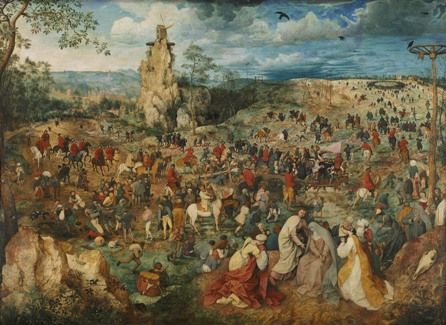
The Way to Calvary, by Pieter Bruegel
Michael Francis Gibson The Mill and the Cross, published by Acatos, Lausanne, in 2001 is a study of Bruegel’s painting, The Way to Calvary. The Author came to Canal Académie’s recording studio to tell us about his research on this work.
The Way to Calvary, one of Peter Bruegel the Elder’s larger paintings, now at Kunsthistorisches Museum in Vienna ostensibly relates an episode of the Passion of Christ. Painted in 1564, the work measures 170 cm by 124 cm and represents a broad landscape populated by about 500 figures that are mostly moving from the town, in the background to the left to Golgotha in the background to the right. Other figures, peasants, shepherds and day labourers are heading into town carrying the ware they hope to sell on the market.
In their midst, the condemned men, Christ and the two thieves, are heading to the place of their execution surrounded by a troop of soldiers wearing red tunics and preceded by the two-headed eagle of the Habsburgs.

This suggests that the subject of the painting is twofold. It obviously relates the story of Christ’s Passion, but it also refers to the brutal political and religious repression that the Low-Countries experienced in Bruegel’s dayS, when the Spanish authorities put heretics to death, “the men by the sword, the women buried alive.” The Reformation was enjoying considerable success at the time, in Flanders and Brabant.
The scene is complex and almost takes the shape of a film script that the eye explores and discovers by successive stages.
One might even say that it’s a very large miniature. Some of the details are so tiny that it would appear desirable to examine all of it under a magnifying glass.


The scene is dominated by a tall and improbable rock formation capped with an equally improbable mill. The obvious question here is: how on earth did they manage to carry the grain up to be ground and the flour down to be sold?
Bruegel’s mill is presumably a symbolic form, and it is interesting to note that the miller is shown standing, cut ouj against the sky, just outside the mill, at the very spot where the Flemish pictorial tradition put the figure of God the Father, observing the earth and its inhabitants from his throne in the clouds. This suggests that the mill is a metaphor for the starry heavens that turn day and night above our heads like a great mill.
Although Christ himself can be found at the precise centre of the painting, he is well hidden: a tiny figure dressed in grey in the middle of the crowd. It’s hard to make him out at first glance. This appears to suggest that the decisive events that change the course of history go unnoticed when they occur.

In the foreground, the Virgin and the Holy Women with Saint John are treated in a style that is quite different from the rest of the painting – an archaic style reminiscent used by van Eyck or van der Weyden 150 years earlier. The contrast between the tragic pathos of this group and humorous realism with which the crowd is depicted is typical of Bruegel. In view of the artist’s breadth of vision we could justifiably call him the Shakespeare of Flanders.
And it is Bruegel himself whom we finally recognize, on the edge of the painting to the right, observing the scene which he will shortly be painting. One might even venture to imagine that the man weeping beside him is his friend Nicholas Jonghelinck, who was to acquire the painting for his collection.
The painting is consequently a religious, moral and political meditation on human violence, indifference and unawareness.

Michael Francis Gibson is art Critic, art historian, anthropologist, journalist, writer, in English and French.
Since 1970, Michael F. Gibson wrote regularly on art and culture in the International Herald Tribune and many other publications (New York Times, Art in America, The Drama Review, Connaissance des Arts, etc.).
His monograph on Dadaïsme and Marcel Duchamp (Duchamp-Dada, NEF-Casterman, 1991), received the International Art Book Award of the Vasari Prize in 1991. Michael F. Gibson wrote a number of other monographs, for instance on Paul Gauguin (Polygrafa), Odilon Redon, Symbolist Art (Taschen), or Alexander Calder.
Michael F. Gibson, together with the polish film director, Lech Majewski, is currently (in 2008) working the script of a documentary fiction devoted to Bruegel’s « The Way to Calvary »
Michael Gibson, The Mill and the Cross, Acatos, Lausanne, 2001
A French version was published under the title Portement de croix, Histoire d’un tableau de Pierre Bruegel l’Aîné, by Michael Gibson, Noêsis, Collection L’œuvre, Paris 1996.
Miguel Errazu, Chronicles of the Greater Dream, First Episode, The Riddle of the Seal, The University of Levana Press, 2007.